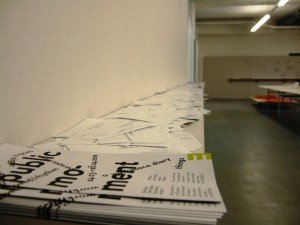Anzeige, tagebook der PLATFORM
Künstler im Gespräch: Franck Leibovici
- Call for Videos - 3. Mai 2012
- Critical Voices - 30. April 2012
- Bücher und die Tauben - 29. April 2012

PLATFORM3 feiert das dreijährige Bestehen mit einem kollektiven Projekt der Künstler vor Ort. Initiiert und begleitet wird es vom internationalen Künstler Franck Leibovici (1975, FR), der die folgende Frage stellt: Wie erschließt sich das Ökosystem eines Kunstwerkes? Ein Interview:
Durch Workshops mit den Künstlern und dem kuratorischen Team von PLATFORM3 wurde ein neuartiges Ausstellungskonzept entwickelt. Das gemeinsame Projekt, „a public moment“, läuft bis zum 28. April.
Wir danken dem viel beschäftigten Franck für das Interview, der sich trotz Zeitmangels unseren Fragen widmete.
Hast du dich immer für kollektive Projekte interessiert? Was war die Inspiration hinter diesem Projekt, „a public moment“?
brasilien (rio) und poesie.
rio, da ich dort entdeckt habe, dass es ein guter test für die evaluierung eines kunstwerkes ist, zu prüfen, ob dieses ein kollektiv generiert. wenn nicht, hielt man das werk für „interessant“. wenn dabei aber ein kollektiv entsteht und emotionen hervorruft, dann eignete sich die gruppe es sofort an.
poesie, aus dem grund, dass die grundlegende fragestellung dieses bereichs immer wieder aufkommt: zu welcher art von „lebensform“ führt uns die praxis des schreibens, die ich entwickele?
Eine der ersten Fragen, die du den Künstlern von PLATFORM3 gestellt hast, war: Welche Praktiken gehören zu dem Ökosystem eures Kunstwerkes? Im Laufe zweier Workshops haben wir gemeinsam Schlagwörter erstellt, um die Ökosysteme der PLATFORM3 Künstler zu beschreiben. Wie würdest du diese Frage selber beantworten?
durch projekte wie „forms of life“ und „a public moment“.
Bist du auf irgendetwas Unerwartetes im Laufe dieses Projekts gestoßen? Hast du vielleicht ein neues Element entdeckt, das du in einem neuen Projekt integrieren möchtest?
ja, neue wege, phänomene zu beschreiben, die für „immateriell” gehalten werden.
Die kollektiven Projekte, die du initiierst, stammen von deiner Idee, dass das Kunstwerk mehr als ein Objekt, eher ein Teil gemeinsame Gesten und Situationen in Folge ethischer, politischer sowie ökonomischer Künstlerpositionen ist. Warum ist so eine Annäherung an Kunst wichtig, vielleicht heutzutage sogar notwendig?
da wir heutzutage nicht wissen, was überhaupt ein objekt ist. ein objekt ist nicht das, was wir denken. es ist mehr als das…
und wir wissen auch nicht, was eine praxis ist. (und sie ist zudem mehr als das).
Wie hast du diese Idee, dass das Kunstwerk zu einem Ökosystem gehört, entwickelt?
es gehört nicht nur dazu, sondern erzeugt auch selbst.
indem man versucht, zu verstehen oder zu beschreiben, wie menschen kunstwerke nutzen, oder wie sie sie funktionieren lassen.
und, indem man versucht, diese sachen zu beschreiben, die bis dato keine darstellungsformen oder visualisierungen haben.
a public moment
24. März – 28. April 2012
Mo-Sa 11-19h; Mi 12-20h; Sonntags geschlossen
KOSTENLOSER EINTRITT!
Mehr Informationen zu Künstler: leslaboratoires.org und ubu.com
Mehr Informationen zu PLATFORM3: platform3.de und Facebook
Aus dem Englischen übersetzt von Carina Essl.
_________________________________________________________
In celebration of the third anniversary of PLATFORM3, the international artist Franck Leibovici (1975, France) initiated a survey among the on-site artists, posing the question: How can the ecosystem of an artwork be made accessible? Through a series of workshops with the artists and the curatorial team of PLATFORM3, an experimental exhibition concept was created. The collective project, “a public momentâ€, is open until April 28.
We are very happy that Franck, very busy indeed, has taken the time to let us get to know him a little better.
Have you always been interested in collective projects? What was the inspiration behind this project, “a public moment�
brasil (rio) and poetry.
rio because i discovered that there, a good test to evaluate an artwork was to see if it was producing a collective or not. if not, the work was considered “interestingâ€, but if it was producing a collective and the affects related to it, then it was immediately appropriated by the group.
poetry because one of the basic questions that this field keeps asking is: towards what kind of “form of life†is the practice of writing i’m developing leading us?
One of the first questions you posed to the artists of PLATFORM3 was: What practices belong to the ecosystem of your artwork? Over the course of two weekend workshops we collectively developed a set of keywords to describe the ecosystems of the PLATFORM3 artists. How would you answer this question for yourself?
by projects such as “forms of life†or “a public momentâ€.
Did you encounter anything unexpected during this project? Or perhaps uncover a new element which you would like to incorporate in a new project?
yes, new ways of describing phenomena considered as “immaterialâ€.
The collective projects which you initiate are based on your belief that artwork is more than an object, but rather a set of collective gestures and situations as the result of an artist’s ethical, political and economic positions. Why do you believe such an approach to art is important, or perhaps necessary, today?
because we do not know what an object is, today. an object is not what we think. it’s more than that…
and we do not know what a practice is either. (and it’s more than that, too).
How did you develop this idea that artwork belongs to an entire ecosystem?
not only belongs to, but produces also.
by trying to understand or to describe how people use, or make artworks function.
and, but trying to describe those things which do not have yet representations or visualizations.
a public moment
March 24 - April 28, 2012
Mo-Sa 11am-7pm;Â We 12pm-8pm; closed Sundays
FREE ADMISSION!
More information about the artist: leslaboratoires.org and ubu.com
More information about PLATFORM3: platform3.de and Facebook




No Comments